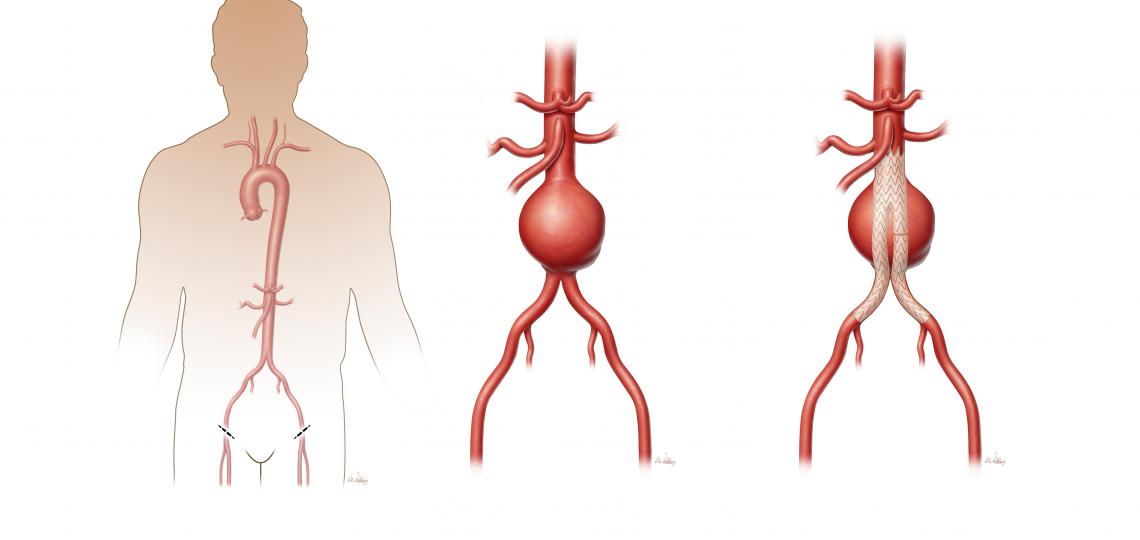Endovascular repair of abdominal aortic aneurysm (AAA). Incision sites (left), aneurysm (center), stent placed (right).
Your aorta is a tube-like structure that resembles a candy cane. The thoracoabdominal aorta starts after the curve of the cane and extends past the arteries that deliver blood to the stomach, intestines and kidneys.
An aneurysm refers to ballooning out of the aorta which causes aortic wall weakening. The aortic wall may continue to further expand or remain unchanged, but close surveillance is necessary. As the aortic wall weakens, there is a risk of the wall tearing or dissecting.
What Contributes to the Formation of an Aneurysm?
- Age and/or degenerative disease of the aortic wall
- Uncontrolled high blood pressure
- Long-term use of tobacco
- Inflammation or swelling of the aorta
- Infection
- Past medical history of connective tissue disorders, such as Marfan syndrome, Ehlers-Danlos syndrome or Loeys-Dietz syndrome
- Trauma
Diagnosis and Symptoms
Individuals with descending thoracic or abdominal aortic aneurysms usually do not have symptoms. Aneurysms are commonly found incidentally. It is possible that as the aneurysm enlarges and compresses surrounding nerves or organs, an individual may experience back or abdominal pain.
Patients that experience sudden symptoms such as chest or back pain, characterized as a tearing sensation, nausea, vomiting, a fast heartbeat and possibly the feeling of impending doom, may be experiencing a tear or dissection of the aorta. Left untreated this can lead to rupture and is considered an emergent condition that requires immediate intervention.
Computed tomography or CT scan with or without contrast is the most common imaging study used to evaluate your condition. A CT scan provides valuable information about your aorta, such as the location and size of an aneurysm or dissection. Magnetic resonance imaging (MRI) or magnetic resonance angiography (MRA) is another imaging modality to visualize your aortic aneurysm and vessels. Similar to a CT scan with contrast, an MRI or MRA provides detailed information about your aorta. Your surgeon will choose the best method for imaging your aorta.
Endovascular Repair of the Aorta
During this operation, the surgeon will make an incision, called a median sternotomy, in your chest and through the breastbone.
In order to perform surgery on your aorta, it is necessary to connect you to a heart-lung bypass machine. This machine takes over the work of the heart circulating oxygenated blood throughout the body. During your surgery, the diseased portion of your aorta will be replaced with a Dacron® graft. If you have an arch aneurysm, it is possible that you may also require bypass grafts to replace vessels that supply blood to your head.
While repairing your aorta, your surgeon will inspect your aortic valve to determine whether it can be spared or may need replacement, which is done at the same time as your aneurysm surgery. Please, see the separate insert about valve replacement for more information.
Recovery
It will take you approximately one month to fully recover from undergoing endovascular aortic aneurysm surgery. You should plan to be away from work, getting your full strength back, for approximately four weeks. Your surgeon will advise you on post-operative restrictions and when it's safe to drive again.








 Credit
Credit
